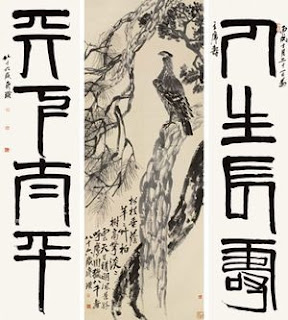As I mentioned in a blog post back in June, one of the big stories of the Spring Auctions held in Beijing and Hong Kong was the $65,399,350 paid for a painting by Qi Baishi, “Eagle Standing on a Pine Tree with Four-character couplet in Seal Script” at China Guardian Auctions on May 22nd. A truly astounding price and frankly, hard to understand. True, its provenance was impressive. Qi Baishi intended it as a gift for Chiang Kai-shek’s 60th birthday, and the seller was well-known Shanghai billionaire collector Liu Yiqian. But who was the buyer?? Much has been made of the China’s booming economy and rapidly expanding class of millionaires and billionaires. However, there is another explanation that has less to do with passion for art or even conspicuous consumption. As it turns out the buyer was a corporation, not an individual collector. Artron.net has reported that the Hunan TV & Broadcast Intermediary Co. Ltd. purchased the painting, adding it to a collection of hundreds of ink and oil paintings by modern masters. That the buyer is a corporation lends support to the idea that the current Chinese art market is speculative, and that it is investment groups and corporations that are driving the Chinese art market into the stratosphere. According to a recent article “investing” cash in the Chinese art market is looking even more attractive to Chinese tycoons and corporations due to an overheated real estate market. This along with growing inflation and low interest rates leaves few investment options in China.
Author Archives: Lydia Thompson
Song Zhuang Art District, Beijing
One of the most interesting places I visited on my trip to China in early June was the Song Zhuang Art District on the outskirts of Beijing. We were taken by our friend Liu Yan who kindly arranged for us to meet with Shao Qi, an art gallery director, and to visit the studios of artists, Liu Liguo and Chen Qing Qing. The first artists moved to Song Zhuang in the mid-1990s after the government pushed them from their neighborhoods in Beijing to make room for new development projects. Looking for a new place to work, the artists moved to a rural village that would be somewhat removed from the purview of the state. Since then the artists have turned Song Zhuang from a backwater to a thriving artist colony which now numbers around 4000, including international art stars like Fang Lijun and Yue Minjun as well as thousands of struggling and foreign artists.
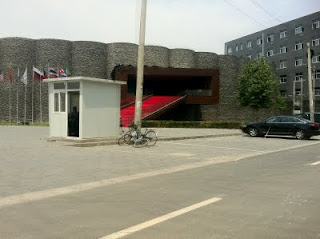 After driving for about 45 minutes away from the center of Beijing we arrived at what first appears to be a rather non-descript suburb with roads lined with small stores selling paint, pipes and vegetables. However, as our driving tour continued we were astounded to see a series of imposing, architecturally striking museums and galleries under construction. Those that were completed were mostly empty or closed.
After driving for about 45 minutes away from the center of Beijing we arrived at what first appears to be a rather non-descript suburb with roads lined with small stores selling paint, pipes and vegetables. However, as our driving tour continued we were astounded to see a series of imposing, architecturally striking museums and galleries under construction. Those that were completed were mostly empty or closed.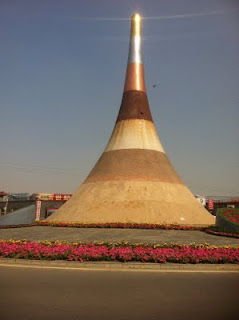 Equally anomalous was a massive sculpture created by Fang Lijun set in the middle of a round-about. At first it struck me as looking like an over-sized Hersey’s Kiss. But, as Shao Qi explained, the different colored and textured layers represent the hierarchy of Chinese society with the wide thick base made of earth identified with the peasant class supporting six more ever-diminishing layers up to the golden pinnacle representing China’s political and business elite – a wry commentary on the disparity of wealth and power in China today.
Equally anomalous was a massive sculpture created by Fang Lijun set in the middle of a round-about. At first it struck me as looking like an over-sized Hersey’s Kiss. But, as Shao Qi explained, the different colored and textured layers represent the hierarchy of Chinese society with the wide thick base made of earth identified with the peasant class supporting six more ever-diminishing layers up to the golden pinnacle representing China’s political and business elite – a wry commentary on the disparity of wealth and power in China today.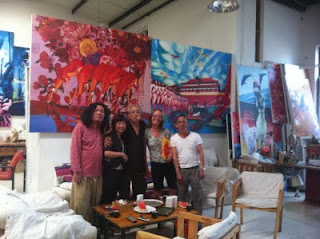
Records set at Beijing Poly
Much as I would have liked to post more during my stay in Beijing and Shanghai, the Great Firewall of China prevented me from doing so (except when I was staying at my friend’s place in Beijing which has VPN). Not only does the Great Firewall reject logging in to Facebook and Twitter but it also prevented me from accessing my own blog. I guess “blog” is a dirty word in China.
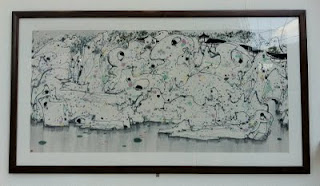
Even more eye-popping was a landscape painting by the iconic 14th century master Wang Meng which sold for 402.5 million RMB or around US$62 million, the third highest price ever paid for a Chinese work at auction. This came on the heels of the China Guardian sale of a hanging scroll awkwardly entitled “Eagle Standing on a Pine Tree with Couplet” by the great ink painter Qi Baishi which sold for more than US$65 million. Born in 1864 in central China’s Hunan Province, Qi Baishi is especially revered for his depiction of small things, such as birds, fish, fruit and vegetables. He was also known as an outstanding calligrapher. Figures from the art market data organization Art Price show that Qi’s works raked in more than 70 million U.S. dollars in sales worldwide in 2009, only behind the works of Pablo Picasso and Andy Warhol.
Hong Kong auctions completed and Poly Auctions underway…
With the Hong Kong sales just ending and the Beijing Poly sales now underway, it looks like another banner season for the Chinese art auction market. Christie’s Hong Kong finished up with a record almost US$500 million in sales at their May auctions. And, of course, China Guardian sales made big news with a painting by modern master Qi Baishi selling for $65 million. Who is driving the market? The newly minted Chinese millionaires (who now number more than a million)including financiers and private company owners who are putting their money in Chinese art…everything from porcelains to contemporary art. One group in particular, Shaanxi coal mine owners, are, to quote one Shanghai-based dealer, “are very comfortable” putting their cash into art. And from the looks of some of the more aggressive bidders last night at the modern ink painting sale last night, this appears to be true. Missing at the auction were foreign buyers. This is in part due to the restrictions on what can be taken out of China; it is also due to the different tastes of domestic and overseas collectors of Chinese art. However, this may change soon as Beijing Poly and Guardian get up to speed on attracting foreign buyers to sales which include “overlap” artists, like Liu Ye, Yue Minjun, Zhang Xiaogang etc…and start marketing artists popular in China to overseas collectors. According to Forbes magazine, Beijing Poly is considering establishing a branch in New York.
Day 3 in Beijing
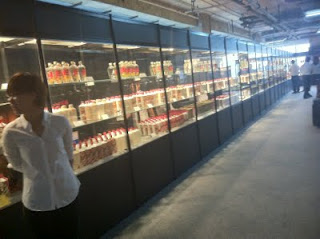 Hazy and hot in Beijing, and the same might be said about the Chinese auction market where backroom dealing may be driving the extraordinary high prices paid at auction. On Monday and Tuesday I attended the preview of Beijing Poly’s Spring sales and was astonished at the volume and quality of Chinese art available.
Hazy and hot in Beijing, and the same might be said about the Chinese auction market where backroom dealing may be driving the extraordinary high prices paid at auction. On Monday and Tuesday I attended the preview of Beijing Poly’s Spring sales and was astonished at the volume and quality of Chinese art available.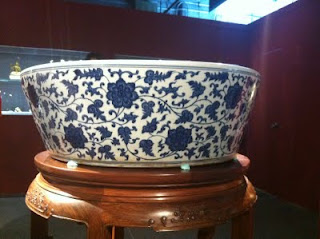 There will be sales of everything from fine Chinese wine to antique automobiles and jewelry to more traditional categories of porcelains, jades, lacquer, furniture, ink painting and works by contemporary Chinese artists. I felt like a kid in a candy store having the opportunity to handle exquisite and rare Ming and Qing porcelains like this imperial washbasin which sold for close to $US4 million, lacquers, jades etc…
There will be sales of everything from fine Chinese wine to antique automobiles and jewelry to more traditional categories of porcelains, jades, lacquer, furniture, ink painting and works by contemporary Chinese artists. I felt like a kid in a candy store having the opportunity to handle exquisite and rare Ming and Qing porcelains like this imperial washbasin which sold for close to $US4 million, lacquers, jades etc…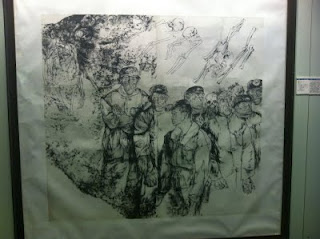 The modern ink painting exhibit was wonderful with masterful works by artists very familiar to Western collector such as Lin Fengmian, Zhang Daqi, Wu Guanzhong, Qi Baishi, as well as with works by artists famous in China but less known in the West, such as Zhang Ding, Fan Zeng and Zhou Sicong (1939-1995) whose painting, “Miners”, sold for around US$2.5 millon. What really drew me to Beijing Poly’s Spring Auctions was the sale of part of the Ullens Collection of contemporary Chinese art. The Ullens are Belgian collectors who established the Ullens Center at 798 Art District and are in the process of shifting their focus from Chinese art to contemporary Indian art for reasons that would be a good subject for a future blog post.
The modern ink painting exhibit was wonderful with masterful works by artists very familiar to Western collector such as Lin Fengmian, Zhang Daqi, Wu Guanzhong, Qi Baishi, as well as with works by artists famous in China but less known in the West, such as Zhang Ding, Fan Zeng and Zhou Sicong (1939-1995) whose painting, “Miners”, sold for around US$2.5 millon. What really drew me to Beijing Poly’s Spring Auctions was the sale of part of the Ullens Collection of contemporary Chinese art. The Ullens are Belgian collectors who established the Ullens Center at 798 Art District and are in the process of shifting their focus from Chinese art to contemporary Indian art for reasons that would be a good subject for a future blog post.
